2019-06-06 - Nº 214
Editorial
Esta é a Newsletter Nº 214 que se apresenta com o mesmo formato que as anteriores. Se gostar da Newsletter partilhe-a!
Todas as Newsletters encontram-se indexadas no link.
Esta Newsletter tem os seguintes tópicos:
Faz hoje anos que nascia, em 1850, Karl Ferdinand Braun. Este físico alemão partilhou o Prémio Nobel da Física em 1909 com Guglielmo Marconi pelo desenvolvimento do telegrafo sem fio. Ele publicou artigos sobre desvios da lei de Ohm e sobre os cálculos da força electromotriz de elementos galvânicos reversíveis de fontes térmicas, e descobriu (1874) o efeito do rectificador eléctrico. Ele demonstrou o primeiro osciloscópio de raios catódicos (tubo de Braun) em 1897, depois de trabalhar em correntes alternadas de alta frequência. Os tubos de raios catódicos já tinham sido caracterizados por raios não controlados; Braun conseguiu produzir um fluxo estreito de electrões, guiado por meio de voltagem alternada, que poderia traçar padrões numa tela fluorescente.
Faz também anos hoje que nascia, em 1932, David Scott. Este Astronauta norte-americano foi o primeiro a conduzir um veículo com rodas na Lua a 31 de Julho de 1971. O Foguetão Gemini 8 foi lançado em 16 de Março de 1966, com Scott e Neil Armstrong como tripulantes e conduziu a primeira ancoragem no espaço com um Agena. Scott voou na missão Apollo 9, lançada em 3 de Março de 1969, um teste de órbita terrestre de dez dias do primeiro conjunto completo de hardware da Apollo. Em 26 de Julho de 1971, Scott foi lançado na missão Apollo 15. Ele estava no comando do seu Módulo Lunar, que fez o quarto pouso lunar, tornou-se a sétima pessoa a andar na Lua e o primeiro a usar o veículo Lunar Rover na superfície da Lua. Isto fez parte de uma investigação científica de três dias, onde foram recolhidas cerca de 77 kg de amostras de rochas, e uma estação de ciência da ALSEP foi deixada no local de pouso para continuar a monitorização do ambiente lunar.
Faz igualmente anos hoje que nascia, em 1933, Heinrich Rohrer. Este Físico suíço recebeu metade do Prémio Nobel de Física de 1986 com Gerd Binnig, pela invenção conjunta do microscópio de tunelamento. (Ernst Ruska recebeu a outra metade do prémio). O microscópio electrónico de Ruska dos anos 1930 foi incapaz de mostrar a estrutura da superfície no nível atómico. Rohrer e Binnig começaram a trabalhar em 1978 num microscópio de tunelamento de varredura no qual uma sonda fina passa a poucos angstroms da superfície da amostra. Uma voltagem positiva na sonda permite que os electrões se movam da amostra para a sonda pelo efeito de túnel, e a corrente detectada pode ser usada para manter a sonda a uma distância constante da superfície. À medida que a sonda se move em linhas paralelas, uma imagem 3D da superfície pode ser construída.
Por fim, faz anos hoje que nascia, em 1943, Richard E. Smalley. Este químico e físico norte-americano ficou conhecido como o pai da nano-tecnologia, que dividiu o Prémio Nobel de Química de 1996 com Robert F. Curl Jr. e Sir Harold W. Kroto pela descoberta conjunta, em 1985, de carbono (C60, ou Buckminsterfulereno, ou "buckyballs") e os fulerenos.
Completam-se hoje 35 anos desde o lançamento desse jogo mundialmente famoso chamado Tetris. O Tetris foi originalmente concebido e desenvolvido pelo programador russo Alexey Leonidovich Pajitnov. O seu nome é derivado das palavras "tetromino", que é uma forma geométrica composta por quatro quadrados, e "ténis", supostamente o desporto favorito de Pajitnov.
Nesta semana que passou ficamos a conhecer o novo pneu sem ar desenvolvido pela Michelin. Juntamente com a GM o prototipo MICHELIN Uptis (ou “Unique Puncture-proof Tire System”) foi apresentado. A tecnologia sem ar faz com que o Uptis Prototype elimine furos e rebentamento de pneus. Isto significa que o Uptis oferece um potencial significativo para reduzir o uso de matérias-primas e resíduos, contribuindo para a visão da GM para um mundo com zero colisões, zero emissões e zero congestionamentos.
Também esta semana a KLM e TU Delft unem forças para tornar a aviação mais sustentável. A KLM contribuirá para a pesquisa da TU Delft sobre um conceito de voo inovador conhecido como "Flying-V". O desenho em forma de V da aeronave integrará a cabine de passageiros, o porão de carga e os tanques de combustível nas asas. A sua forma aerodinâmica aperfeiçoada e peso reduzido significam que ele consome 20% menos combustível do que o Airbus A350, a aeronave mais avançada da actualidade. Um modelo em escala voadora e uma secção em tamanho real do interior do Flying-V serão oficialmente apresentados no KLM Experience Days no Aeroporto Schiphol de Amesterdão em Outubro, por ocasião do 100º aniversário da KLM.
Também nesta semana que passou a Amazon, na sua conferência re: MARS, (Machine Learning, Automation, Robotics and Space), em Las Vegas, revelou o mais recente desenho de drones Prime Air. O objectivo destes drones é serem totalmente eléctricos e poder voar até 15 milhas e entregar pacotes com menos de cinco libras a clientes em menos de 30 minutos.
Na Newsletter desta semana apresentamos diversos projetos de maker. É apresentada a revista newelectronics de 28 de Maio.
 João Alves ([email protected])
João Alves ([email protected])
O conteúdo da Newsletter encontra-se sob a licença  Creative Commons Attribution-NonCommercial-ShareAlike 4.0 International License.
Creative Commons Attribution-NonCommercial-ShareAlike 4.0 International License.
Novidades da Semana

Michelin, GM Take the Air Out of Tires for Passenger Vehicles
"Michelin and General Motors presented a new generation of airless wheel technology, the MICHELIN Uptis Prototype (or “Unique Puncture-proof Tire System”), at the Movin’On Summit for sustainable mobility. GM intends to develop this airless wheel assembly with Michelin and aims to introduce it on passenger vehicles as early as 2024. Later this year, GM will initiate real-world testing and validation of the Uptis Prototype on a Michigan test fleet of Chevrolet Bolt EVs. “General Motors is excited about the possibilities that Uptis presents, and we are thrilled to collaborate with Michelin on this breakthrough technology,” said Steve Kiefer, senior vice president, Global Purchasing and Supply Chain, General Motors. “Uptis is an ideal fit for propelling the automotive industry into the future and a great example of how our customers benefit when we collaborate and innovate with our supplier partners.” Airless technology makes the Uptis Prototype eliminate flats and blowouts. This means Uptis offers significant potential for reducing the use of raw materials and waste, contributing to GM’s vision for a world with zero crashes, zero emissions and zero congestion as it: Reduces the number of punctured or damaged tires that are scrapped before reaching the end of their life cycle." [...]

KLM and TU Delft join forces to make aviation more sustainable
"KLM President & CEO Pieter Elbers and Dean of the Faculty of Aerospace Engineering at Delft University of Technology (TU Delft) Professor Henri Werij today signed a new cooperative agreement to work together on making aviation more sustainable at the IATA Annual General Meeting in Seoul. KLM will be contributing towards TU Delft’s research into an innovative flight concept known as the “Flying-V”, which embraces an entirely different approach to aircraft design, in anticipation and support of sustainable long-distance flight in the future. The aircraft’s v-shaped design will integrate the passenger cabin, the cargo hold and the fuel tanks in the wings. Its improved aerodynamic shape and reduced weight will mean it uses 20% less fuel than the Airbus A350, today’s most advanced aircraft. A flying scale model and a full-size section of the interior of the Flying-V will be officially presented at the KLM Experience Days at Amsterdam Airport Schiphol in October on the occasion of KLM’s 100th anniversary. The aircraft was originally conceptualised as a potential aircraft design for the future, but can be compared to today’s most advanced aircraft, the Airbus A350." [...]
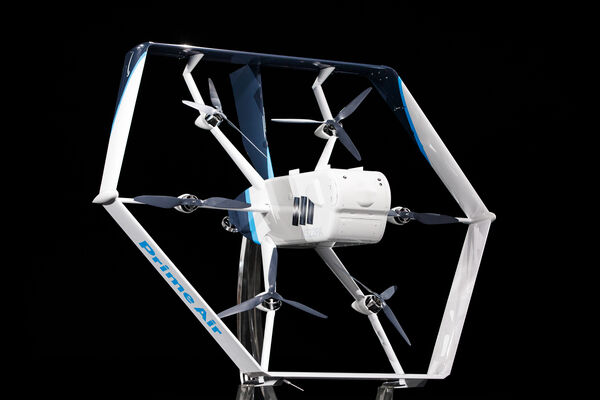
A drone program taking flight
"Amazon moves closer to its goal of a drone delivery solution that scales to meet the needs of customers. When we announced earlier this year that we were evolving our Prime two-day shipping offer in the U.S. to a one-day program, the response was terrific. But we know customers are always looking for something better, more convenient, and there may be times when one-day delivery may not be the right choice. Can we deliver packages to customers even faster? We think the answer is yes, and one way we’re pursuing that goal is by pioneering autonomous drone technology. Today at Amazon’s re:MARS Conference (Machine Learning, Automation, Robotics and Space) in Las Vegas, we unveiled our latest Prime Air drone design." [...]
Outras Notícias

PCI-SIG® Achieves 32GT/s with New PCI Express® 5.0 Specification
"PCI-SIG® today announced the release of PCI Express® (PCIe®) 5.0 specification, reaching 32GT/s transfer rates, while maintaining low power and backwards compatibility with previous technology generations. “New data-intensive applications are driving demand for unprecedented levels of performance,” said Al Yanes, PCI-SIG Chairman and President. “Completing the PCIe 5.0 specification in 18 months is a major achievement, and it is due to the commitment of our members who worked diligently to evolve PCIe technology to meet the performance needs of the industry. The PCIe architecture will continue to stand as the defacto standard for high performance I/O for the foreseeable future.” “For 27 years, the PCI-SIG has continually delivered new versions of I/O standards that enable designers to accommodate the never-ending increases in bandwidth required for next generation systems, while preserving investments in prior generation interfaces and software,” noted Nathan Brookwood, research fellow at Insight 64. “Over that period, peak bandwidth has increased from 133 MB/second (for the first 32-bit parallel version) to 32 GB/second (for the V4.0 by16 serial version), a 240X improvement. Wow!" [...]
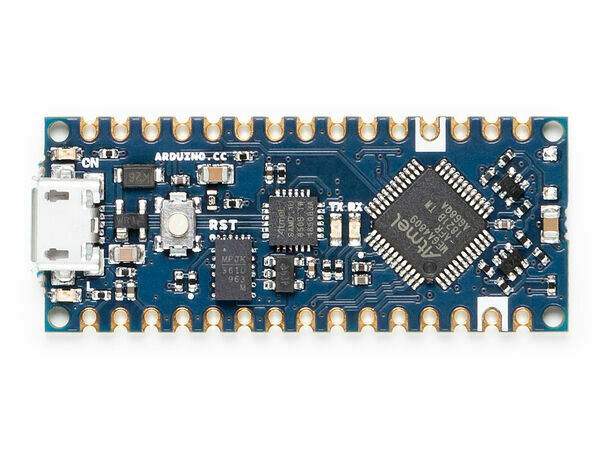
Getting started with the new Arduino Nano Every
"The original Arduino Nano occupies a special place in many makers’ hearts. The tiny footprint (48×18 mm — around half a stick of gum), reliability and tons of examples makes the Nano perfect for wearables, drones — in fact any project made to last. The Nano is back! The new entry-level Arduino Nano Every manages to pack in even more features at an even lower price — just $9.90 / €8.00 without headers — and is backwards compatible with the original. Dario Pennisi led the development of the board, so we sat down with him to learn more. The size of Arduino Nano Every makes it ideal for wearable projects; in experiments, in prototypes or in a full cosplay setup!" [...]

Infineon To Acquire Cypress, Strengthening And Accelerating Its Path Of Profitable Growth
"Munich, Germany, and San Jose, California – 3 and 2 June 2019 – Infineon Technologies AG (FSE: IFX / OTCQX: IFNNY) and Cypress Semiconductor Corporation (NASDAQ: CY) today announced that the companies have signed a definitive agreement under which Infineon will acquire Cypress for US$23.85 per share in cash, corresponding to an enterprise value of €9.0 billion. Reinhard Ploss, CEO of Infineon, said: “The planned acquisition of Cypress is a landmark step in Infineon’s strategic development. We will strengthen and accelerate our profitable growth and put our business on a broader basis. With this transaction, we will be able to offer our customers the most comprehensive portfolio for linking the real with the digital world. This will open up additional growth potential in the automotive, industrial and Internet of Things sectors. This transaction also makes our business model even more resilient." [...]
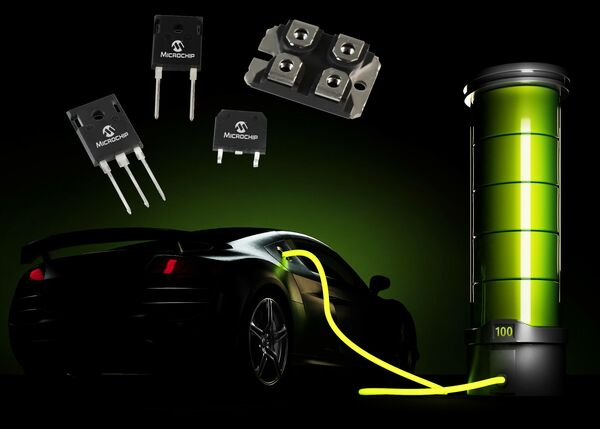
[Microchip Announces Production Release of Silicon Carbide (SiC) Products That Enable High-Voltage, Reliable Power Electronics](https://www.microchip.com/en/pressreleasepage/microchip-announces-production-release-of-silicon-carbide-(sic)
"700 Volt (V) MOSFETs and 700 V and 1200 V Schottky Barrier Diodes (SBDs) extend customer options as demand grows for SiC technology’s efficiency and power density Demand is growing for SiC power products that improve system efficiency, robustness and power density in automotive, industrial and aerospace and defense applications. Microchip Technology Inc. (Nasdaq: MCHP), via its Microsemi subsidiary, today announced the production release of a family of SiC power devices that offer proven ruggedness and the performance benefits of wide-bandgap technology. Complemented by Microchip’s broad range of microcontrollers (MCUs) and analog solutions, the SiC devices join a growing family of reliable SiC products that meet the needs of Electric Vehicles (EVs) and other high-power applications in fast-growing markets. Microchip’s 700 V SiC MOSFETs and 700 V and 1200 V SiC Schottky Barrier Diodes (SBDs) join its existing portfolio of SiC power modules. The more than 35 discrete products that Microchip has added to its portfolio are available in volume, supported by comprehensive development services, tools and reference designs, and offer outstanding ruggedness proven through rigorous testing. Microchip now offers a broad family of SiC die, discretes and power modules across a range of voltage, current ratings and package types." [[...]](https://www.microchip.com/en/pressreleasepage/microchip-announces-production-release-of-silicon-carbide-(sic)

New STMicroelectronics’ STM32H7 Microcontrollers Combine Dual-Core Performance with Rich Feature Integration
"The new STM32H7* microcontrollers (MCU) from STMicroelectronics are the industry’s highest-performing Arm® Cortex®-M general-purpose MCUs, combining dual-core punch with power-saving features and enhanced cyber protection. The new devices leverage a 480MHz version of the Cortex-M7, the highest performing member of Arm’s Cortex-M family, and add a 240MHz Cortex-M4 core. With ST’s smart architecture, efficient L1 cache, and adaptive real-time ART Accelerator™, the MCUs set new speed records at 1327 DMIPS and 3224 CoreMark™[1] executing from embedded Flash. ST’s Chrom-ART Accelerator™ delivers an extra boost to graphics performance. To maximize energy efficiency, each core operates in its own power domain and can be turned off individually when not needed. Developers can easily upgrade existing applications through flexible use of the two cores." [...]

NASA's Spitzer Captures Stellar Family Portrait
"In this large celestial mosaic taken by NASA's Spitzer Space Telescope, there's a lot to see, including multiple clusters of stars born from the same dense clumps of gas and dust. Some of these clusters are older than others and more evolved, making this a generational stellar portrait. The grand green-and-orange delta filling most of the image is a faraway nebula, or a cloud of gas and dust in space. Though the cloud may appear to flow from the bright white spot at its tip, it is actually what remains of a much larger cloud that has been carved away by radiation from stars. The bright region is illuminated by massive stars, belonging to a cluster that extends above the white spot. The white color is the combination of four colors (blue, green, orange and red), each representing a different wavelength of infrared light, which is invisible to human eyes." [...]
Ciência e Tecnologia

The ‘Forbidden’ Planet has been found in the ‘Neptunian Desert’
"- A Neptunian planet has been found in what should be a ‘Neptunian Desert’ by telescopes run by the University of Warwick in an international collaboration of astronomers. - NGTS-4b is 20% smaller than Neptune, about 3 times the size of Earth, and has been nicknamed the ‘Forbidden’ planet by researchers - Discovered using the state-of-the-art Next-Generation Transit Survey (NGTS) observing facility, designed to search for transiting planets on bright stars, but NGTS-4b is so small other ground surveys wouldn’t have spotted it. - It’s hotter than Mercury at 1,000 degrees Celsius An exoplanet smaller than Neptune with its own atmosphere has been discovered in the Neptunian Desert, by an international collaboration of astronomers, with the University of Warwick taking a leading role. New research, led by Dr Richard West including Professor Peter Wheatley, Dr Daniel Bayliss and Dr James McCormac from the Astronomy and Astrophysics Group at the University of Warwick, has identified a rogue planet. NGTS is situated at the European Southern Observatory's Paranal Observatory in the heart of the Atacama Desert, Chile. It is a collaboration between UK Universities Warwick, Leicester, Cambridge, and Queen's University Belfast, together with Observatoire de Genève, DLR Berlin and Universidad de Chile." [...]
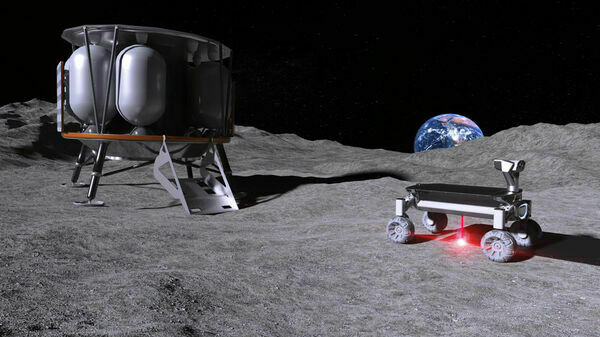
MOONRISE: Bringing 3D-printing to the moon – Melting moon dust with the laser
"With the MOONRISE project, the Laser Zentrum Hannover e. V. (LZH) and the Institute of Space Systems (IRAS) of the Technical University of Braunschweig are aiming at melting moon dust with a laser in order to make it usable as building material. International space agencies and companies are not only planning to further explore, but to colonize space. The moon is of great importance as a research station and starting point for further expeditions. However, the cost of flights and transports to the moon are enormous – a kilogram of loading capacity costs approximately 700,000 Euros. Therefore, infrastructure, components and devices, etc., would at best be manufactured directly on the Earth's satellite. This is where the MOONRISE technology comes in: "We want to bring a laser system to the moon, which is supposed to melt moon dust, the so-called regolith." [...]
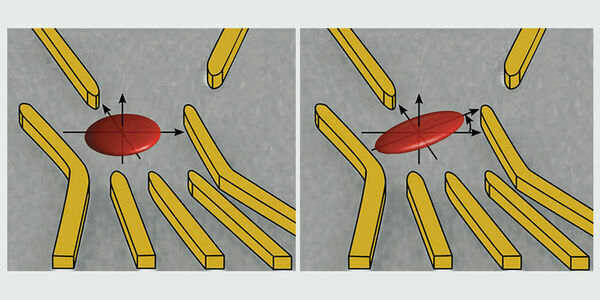
The geometry of an electron determined for the first time
"Physicists at the University of Basel are able to show for the first time how a single electron looks in an artificial atom. A newly developed method enables them to show the probability of an electron being present in a space. This allows improved control of electron spins, which could serve as the smallest information unit in a future quantum computer. The experiments were published in Physical Review Letters and the related theory in Physical Review B. The spin of an electron is a promising candidate for use as the smallest information unit (qubit) of a quantum computer. Controlling and switching this spin or coupling it with other spins is a challenge on which numerous research groups worldwide are working." [...]
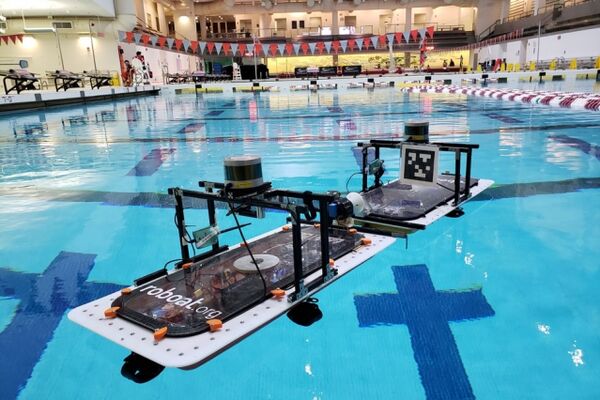
Autonomous boats can target and latch onto each other
"Fleet of “roboats” could collect garbage or self-assemble into floating structures in Amsterdam’s many canals. The city of Amsterdam envisions a future where fleets of autonomous boats cruise its many canals to transport goods and people, collect trash, or self-assemble into floating stages and bridges. To further that vision, MIT researchers have given new capabilities to their fleet of robotic boats — which are being developed as part of an ongoing project — that lets them target and clasp onto each other, and keep trying if they fail. About a quarter of Amsterdam’s surface area is water, with 165 canals winding alongside busy city streets. Several years ago, MIT and the Amsterdam Institute for Advanced Metropolitan Solutions (AMS Institute) teamed up on the “Roboat” project. The idea is to build a fleet of autonomous robotic boats — rectangular hulls equipped with sensors, thrusters, microcontrollers, GPS modules, cameras, and other hardware — that provides intelligent mobility on water to relieve congestion in the city’s busy streets." [...]

A 3-D printer powered by machine vision and artificial intelligence
"MIT startup Inkbit is overcoming traditional constraints to 3-D printing by giving its machines “eyes and brains.” Objects made with 3-D printing can be lighter, stronger, and more complex than those produced through traditional manufacturing methods. But several technical challenges must be overcome before 3-D printing transforms the production of most devices. Commercially available printers generally offer only high speed, high precision, or high-quality materials. Rarely do they offer all three, limiting their usefulness as a manufacturing tool. Today, 3-D printing is used mainly for prototyping and low-volume production of specialized parts. Now Inkbit, a startup out of MIT, is working to bring all of the benefits of 3-D printing to a slew of products that have never been printed before — and it’s aiming to do so at volumes that would radically disrupt production processes in a variety of industries." [...]
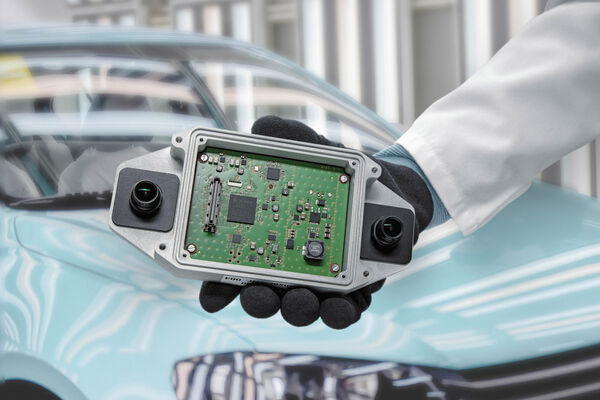
Radar sensor module to bring added safety to autonomous driving
"Researchers at a Fraunhofer Institute in Berlin are developing a combined camera and radar module that can react 160 times faster than a human driver. The project is called KameRad and aims to bring added safety to autonomous driving. When a child runs out onto the road, the average human driver takes 1.6 seconds to hit the brake pedal. The reaction time is cut to 0.5 seconds for automated vehicles fitted with radar/lidar sensors and a camera system. But at a speed of 50 km/h, that still means that the vehicle will continue for another seven meters before the brakes are applied and it comes to a standstill. In response, the Fraunhofer Institute for Reliability and Microintegration IZM has teamed up with a range of partners from both industry (InnoSenT, Silicon Radar, Jabil Optics Germany, AVL, John Deere) and research institutes (Fraunhofer Institute for Open Communication Systems FOKUS, DCAITI) to develop a camera radar module that is significantly faster in capturing changes in traffic conditions." [...]

A cathode material for organic ultrafast metal-ion batteries has been developed
"Researchers from Skoltech Center for Energy Science and Technology, IPCP RAS and D.I. Mendeleev Russian University of Chemical Technology have created a new polymer cathode material for ultrafast metal-ion batteries with superior characteristics. The results of this work were published in the Journal of Material Chemistry A. In recent decades, world energy consumption has been increasing significantly due to population growth, industrialization and the development of household appliances and electronics, with a particular increase in the number of mobile devices and electric vehicles. There is therefore an urgent need to develop electrochemical energy storage technologies and devices. Despite the fact that lithium-ion batteries based on inorganic layered oxides dominate the market, further upgrading their performance is difficult." [...]

Stanford and NASA Ames researchers put inexpensive chip-size satellites into orbit
"A swarm of 105 tiny satellites the size of computer chips, costing under $100 each, recently launched into Earth’s orbit. Stanford scientist Zac Manchester, who dreamed up the ChipSats, said they pave the way for cheaper and easier space exploration. A decade ago, while still a PhD student at Cornell University, Zac Manchester imagined building chip-scale satellites that might work together to study Earth or explore space. On June 3, as NASA Ames Research Center announces the successful deployment of the largest swarm of ChipSats in history, Manchester, now an assistant professor at Stanford, is already envisioning the future of this technology. “This is like the PC revolution for space,” said Manchester, who joined the aeronautics and astronautics faculty last year. “We’ve shown that it’s possible for swarms of cheap, tiny satellites to one day carry out tasks now done by larger, costlier satellites, making it affordable for just about anyone to put instruments or experiments into orbit.” Manchester’s team deployed 105 ChipSats into low-Earth orbit on March 18 and, the next day, detected the signals they sent one another, demonstrating their ability to communicate as a group, a prerequisite to operating as a swarm." [...]
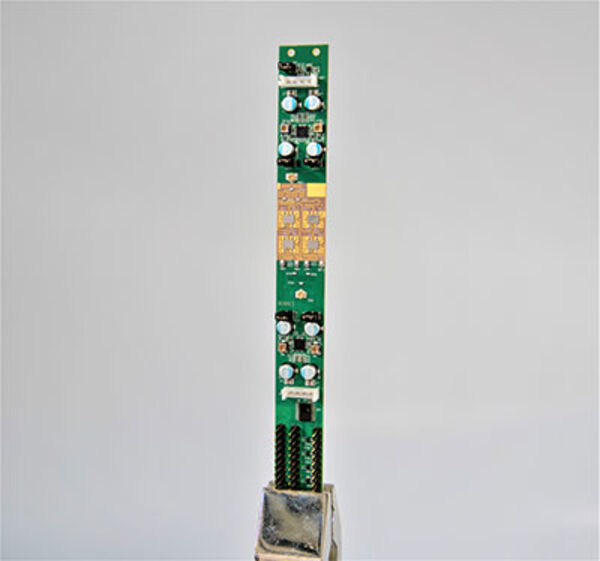
A more accurate, low-cost 39 GHz beamforming transceiver for 5G communications
"Researchers at Tokyo Tech and NEC Corporation, Japan, present a 39 GHz transceiver with built-in calibration for fifth-generation (5G) applications. The advantages to be gained include better quality communications as well as cost-effective scalability. A team of more than 20 researchers at Tokyo Tech and NEC Corporation has successfully demonstrated a 39 GHz transceiver that could be used in the next wave of 5G wireless equipment including base stations, smartphones, tablets and Internet-of-Things (IoT) applications. Although research groups including the current team have until now largely focused on developing 28 GHz systems, 39 GHz will be another important frequency band for realizing 5G in many parts of the world. The new transceiver (shown in Figure 1) is based on a 64-element (4 x 16) phased-array1 design. Its built-in gain phase calibration means that it can improve beamforming2 accuracy, and thereby reduce undesired radiation and boost signal strength." [...]

Engineering Team Develops Bioinks To Print Therapeutics In 3D
"A team of researchers at Texas A&M University has developed an innovative way to print therapeutics in 3D for regenerative medicine. 3D bioprinting is emerging as a promising method for rapidly fabricating cell-containing constructs for designing new, healthy, functional tissues. However, one of the major challenges in 3D bioprinting is lack of control over cellular functions. Growth factors, which are a special class of proteins, can direct cellular fate and functions. However, these growth factors cannot be easily incorporated within a 3D-printed structure for a prolonged duration. In a recent study conducted at Texas A&M, researchers in Dr. Akhilesh K Gaharwar’s lab in the Department of Biomedical Engineering formulated a bioink consisting of 2D mineral nanoparticles to sequester and 3D print therapeutics at precise locations." [...]

Researchers develop superconducting quantum refrigerator
"Imagine a refrigerator so cold it could turn atoms into their quantum states, giving them unique properties that defy the rules of classical physics. In a paper published in Physics Review Applied, Andrew Jordan, professor of physics at the University of Rochester, and his graduate student Sreenath Manikandan, along with their colleague Francesco Giazotto from the NEST Istituto Nanoscienze-CNR and Scuola Normale Superiore in Italy, have conceived an idea for such a refrigerator, which would cool atoms to nearly absolute zero temperatures (about minus 459 degrees Fahrenheit). Scientists could use the refrigerator, which is based on the quantum property of superconductivity, to facilitate and enhance the performance of quantum sensors or circuits for ultrafast quantum computers. What is superconductivity? How well a material conducts electricity is known as conductivity. When a material has high conductivity, it readily allows an electric current to flow through it." [...]
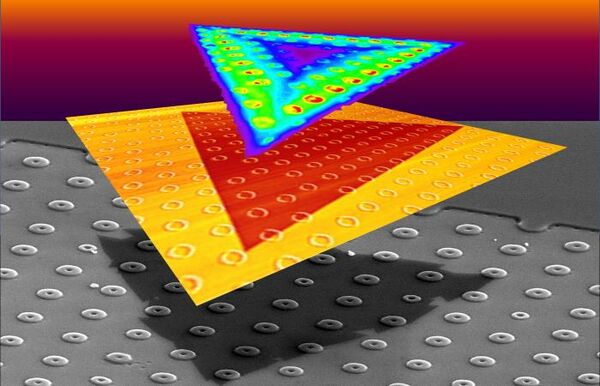
2D crystals conforming to 3D curves create strain for engineering quantum devices
"A team led by scientists at the Department of Energy’s Oak Ridge National Laboratory explored how atomically thin two-dimensional (2D) crystals can grow over 3D objects and how the curvature of those objects can stretch and strain the crystals. The findings, published in Science Advances, point to a strategy for engineering strain directly during the growth of atomically thin crystals to fabricate single photon emitters for quantum information processing. The team first explored growth of the flat crystals on substrates patterned with sharp steps and trenches. Surprisingly, the crystals conformally grew up and down these flat obstacles without changing their properties or growth rates. However, curvy surfaces required the crystals to stretch as they grew to maintain their crystal structure. This growth of 2D crystals into the third dimension presented a fascinating opportunity." [...]

Exploring the science of decision-making
"In a world that offers a seemingly unending number of options and opportunities, people may rely on the overall complexity of alternative options to help them make choices in uncertain environments, according to researchers. In a study recently published in the journal Cognition, the researchers found that when participants faced complex choices, they often showed a burst of exploration before settling into preferred options of higher value. Instead of trying to represent the values of all of the alternatives, adaptive decision-making was supported by selectively maintaining high-value options while forgetting the rest. This strategy may be one way that people can conserve their cognitive resources and solve problems that exceed their working memory capacity. It might, for example, explain why people have their go-to meals when they visit restaurants, said Michael Hallquist, assistant professor of psychology at Penn State and Institute for CyberScience co-hire. “There is a set of neural circuits — and cognitive processes that these circuits instantiate — that help you remember the value of different actions, so if you go to a restaurant and try the steak and it was fantastic, the next time you'll usually remember that," said Hallquist." [...]

Physicists can predict the jumps of Schrödinger’s cat (and finally save it)
"Yale researchers have figured out how to catch and save Schrödinger’s famous cat, the symbol of quantum superposition and unpredictability, by anticipating its jumps and acting in real time to save it from proverbial doom. In the process, they overturn years of cornerstone dogma in quantum physics. The discovery enables researchers to set up an early warning system for imminent jumps of artificial atoms containing quantum information. A study announcing the discovery appears in the June 3 online edition of the journal Nature. Schrödinger’s cat is a well-known paradox used to illustrate the concept of superposition — the ability for two opposite states to exist simultaneously — and unpredictability in quantum physics. The idea is that a cat is placed in a sealed box with a radioactive source and a poison that will be triggered if an atom of the radioactive substance decays." [...]

Manipulating Light-Matter Interaction Unlocks Properties for Quantum Information Storage and Computing
"Newly published findings lay the foundation for smaller, more efficient quantum devices. Researchers at Rensselaer Polytechnic Institute have come up with a way to manipulate tungsten diselenide (WSe2) —a promising two-dimensional material—to further unlock its potential to enable faster, more efficient computing, and even quantum information processing and storage. Their findings were published today in Nature Communications. Across the globe, researchers have been heavily focused on a class of two-dimensional, atomically thin semiconductor materials known as monolayer transition metal dichalcogenides. These atomically thin semiconductor materials—less than 1 nm thick—are attractive as the industry tries to make devices smaller and more power efficient. “It’s a completely new paradigm,” said Sufei Shi, assistant professor of chemical and biological engineering at Rensselaer and corresponding author on the paper." [...]
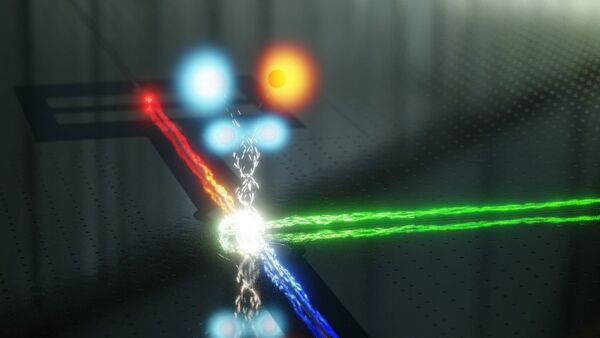
Cracking the Molecular Code with the Right Type of Quantum Hardware
"In the quest to accurately simulate the behavior of chemical entities, quantum computers are expected to offer a significant advantage over their classical counterparts. But to that end, algorithms and the hardware architectures themselves need to be tailored to the specific task at hand. In a collaboration with a co-author affiliated with both Forschungszentrum Juelich and RWTH Aachen University, our team at IBM Research-Zurich now lays out how exchange-type two-qubit gates constitute a very promising avenue to calculate molecular properties. Breakthroughs in materials science are among the main drivers of technological change in the modern world. Understanding the inner workings of the molecules making up those materials is key to designing better drugs, healthier foods or more energy-efficient batteries, to name a few examples. Although the quantum mechanical equations governing the behavior of molecular entities have been known for many decades, solving them still represents a serious challenge even for our best current computers." [...]
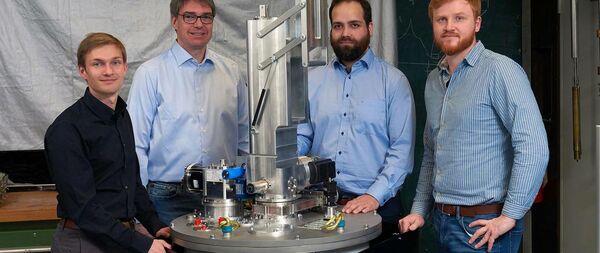
Cooling for quantum electronics
"The start-up kiutra is the first company in the world to have succeeded in developing a permanent magnetic cooling system to reach temperatures close to absolute zero. Such temperatures are, for example, required for the operation of quantum computers. The system was set up by a team of researchers from the Physics Department at the Technical University of Munich (TUM). Low temperatures are essential for basic research in the field of quantum physics. More and more technologies based on quantum mechanics are now also making the leap from the laboratory to commercial applications. High-sensitivity detectors and quantum computers are two well-known examples." [...]

Quantum communication: making two from one
"An electron involved in quantum tunnelling generates two photons much more frequently than theoretically predicted In the future, quantum physics could become the guarantor of secure information technology. To achieve this, individual particles of light – photons – are used for secure transmission of data. Findings by physicists from the Max Planck Institute for Solid State Research could play a key role. The researchers accidentally came across a light source that generates a photon pair from the energy of an electron. One of these particles of light has the potential to serve as a carrier of the fragile quantum information, the other, as a messenger to provide prior notification of its twin. In contrast to quantum communication, a cook has the luxury of being able to look if all the ingredients he or she needs for a recipe are in the cupboard." [...]
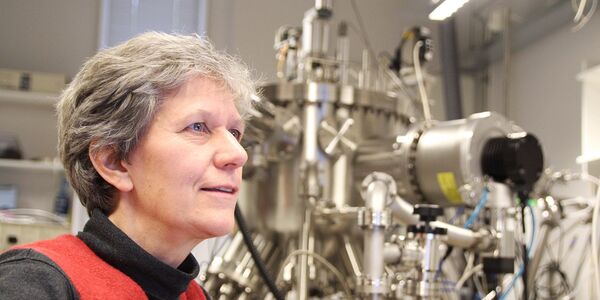
Why you should care about better fibre optics
"Fibre optic research can give us better medical equipment, improved environmental monitoring, more media channels – and maybe better solar panels. “Optical fibres are remarkably good at transmitting signals without much loss in the transfer,” says Professor Ursula Gibson at NTNU’s Department of Physics. However. “Glass fibres are good up to a wavelength of about 3 microns. More than that, and they’re not so good,” she says. And that is sometimes problematic." [...]
Documentação
A documentação é parte essencial do processo de aprendizagem e a Internet além de artigos interessantes de explorar também tem alguma documentação em formato PDF interessante de ler. Todos os links aqui apresentados são para conteúdo disponibilizado livremente pelo editor do livro.

newelectronics 28 Maio 2019
"New Electronics is a fortnightly magazine focusing on technological innovation, news and the latest developments in the electronics sector. Downloadable as a digital page turner or pdf file, or offered as a hard copy, the New Electronics magazine is available in a format to suit you. " [...]
Projetos Maker
Diversos Projetos interessantes.
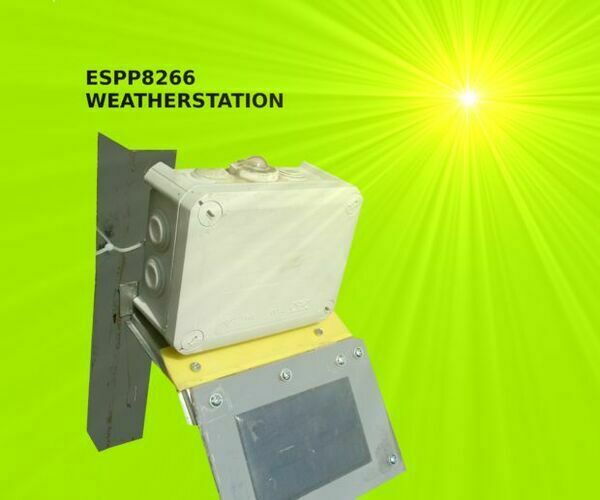
ESP8266 Weatherstation
"I decided show my school work of my own board for weather station based on ESP8266 - 12 with BME280 (as temperature, humidity and pressure sensor) and with photoresistor as detector of sunlight. I add ADC 1115 for get voltage from voltage divider (sunlight measure and voltage from battery). Pros: Using solar cell to charge Lithium - ion battery (18650) Using Wi-Fi to connect ThingSpeak" [...]
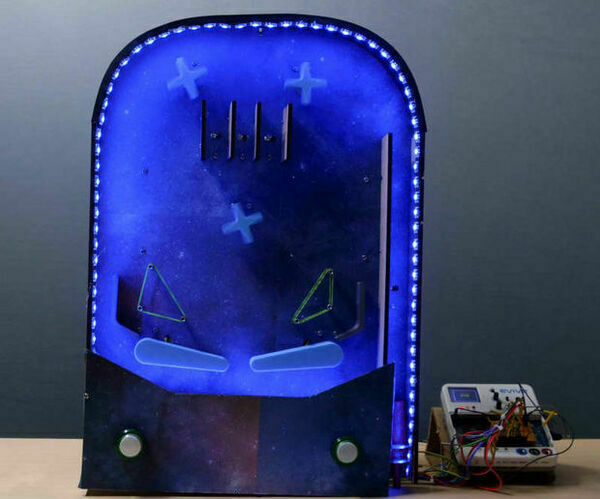
Tabletop Pinball Machine Using Evive- Arduino Based Embedded Plaform
"Another weekend, another exciting game! And this time, its none other than everybodys favorite arcade game - Pinball! This project will show you how to make your very own Pinball machine easily at home. All youd need are components from the evive Starter Kit, some laser-cut parts, colors and papers to decorate your machine, and a lot of DIY-ing! So, bring your mates along, put on your DIY-ing caps, and ready, set, DIY! Weve written the code in PictoBlox - our versatile graphical programming platform with advanced capabilities." [...]
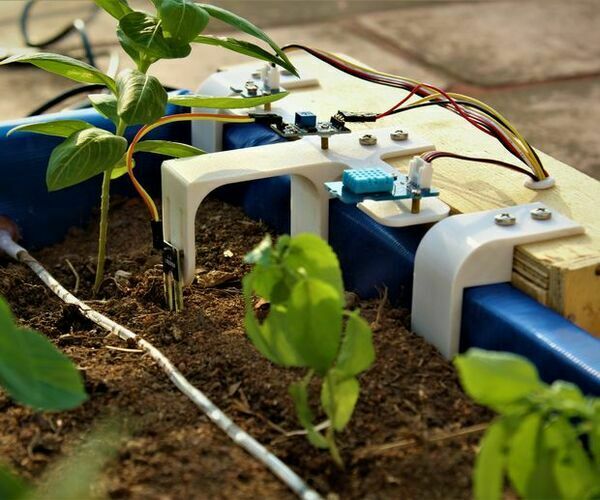
Raspberry Pi Powered IOT Garden
"One of the primary objectives of this project was to be able to maintain the well-being of a garden using the power of the Internet of Things (IoT). With the versatility of the present tools and software, our planter is integrated with sensors that monitor the real-time status of the plants. We built a smartphone app that let's one access the data and take needed actions if necessary. The design of our planter is scalable, low-cost and easy to build, making it the perfect option to add greenery to one's terrace or backyard. The smart garden has proven to be more efficient in water consumption and facilitates maintenance and monitoring. Follow on to learn how to make your very own database and app, by creating a garden that can be monitored by a click of a button!" [...]
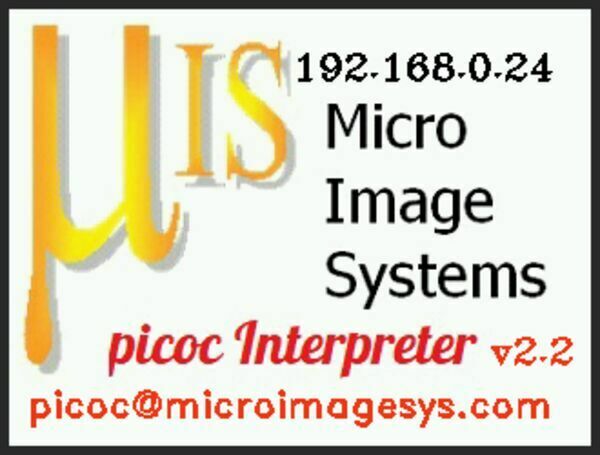
Run a C Language Interpreter on Your ESP32
"Details the Implementation and use of a C Language Interpreter with a browser Interface running on an ESP32 Introduction I've spent considerable time in the Arduino IDE waiting for the sketch to compile and upload only to discover that the sketch did not behave as I expected and to then consider where to add Serial.printx statements to the sketch, wait again for compile and upload, and lose hair trying to get the results I desired. What could be better than putting an if (j==3 && k>11) Debug(); statement into your program and to be able to get debug information out from the program when the variables meet the conditional requirements? So... I put together a C language interpreter for the ESP32 based boards that allows me to use their built-in file system for persistent program storage, to edit and Interpret my programs within a browser page without needing a compile and upload cycle. Better yet, I built in support for the common I/O Arduino functions such as analogWrite, digitalRead/Write, and supplied highly accurate servo positioning functions. But maybe the best part is that I added a debugger to the Interpreter that supports conditional Debug tracing, and conditional Watch functions that report variable values as the program executes." [...]

IoTyper - Control Your PC Via Alexa (IoT)
"Haven' t you ever thought about controlling your PC with IoT? Our World get' s smarter day by day and today we turn our PC in a even smarter PC than it already is. Let' s start! IoTyper is based on two basic MicroControllers: The ATMega 32U4 which can emulate a keyboard, and the ESP8266 that has WiFi capabilities. IoTyper combines both of them. The result is an Gate for your PC to communicate with IoT-devices." [...]
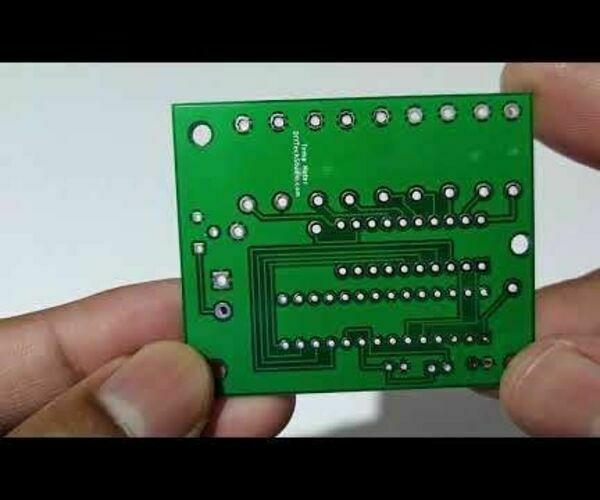
How to Make a Custom DIY Temperature Meter Using Bar Graph & Atmega328p
"In this post i will show you how to make a Temperature Meter using Bar Graph & Atmega328p. The post will include all the details like circuit diagram, PCB fabrication , Coding, Assembly & Testing. I have also included a video containing all the details. " [...]

Freeform ESP8266 OLED MQTT client
"My second freeform creation, or third if we include The CyborgDuck is here. I wanted to do something simple in order to gather more experience and improve my skills. Circuit When I was thinking what to build as a next, simple free-form circuit, my eyes fell on my RoomMonitor project (link is to a GitHub repository with its firmware). That’s one of my long-running projects. Basically, a bunch of sensors connected to ESP8266, battery powered, measures conditions in a room and sends data to some online service via MQTT. Nothing that much interesting." [...]

SKARA- Autonomous Plus Manual Swimming Pool Cleaning Robot
"Time is money and manual labour is expensive. With the advent and advancement in automation technologies, a hassle free solution needs to be developed for homeowners, societies and clubs to clean pools from the debris and dirt of daily life, to maintain their personal hygiene as well as maintain a certain standard of living. Tackling this dilemma head-on, I developed a manual cum autonomous pool surface cleaning machine. With its simple yet innovative mechanisms, leave it in a dirty pool overnight and wake up to clean and speck free one. The automaton has two modes of functionality, one autonomous which can be turned on with the flip of a button on the phone and left unattended to do its job and another manual mode to get those specific pieces of twigs and leaves when time is of the essence. In manual mode you can use accelerometer on your phone to control the robots movement similar to playing racing game on the phone." [...]

Fridge Door Alarm
"In this project I will show you how to make a alarm that will sound if you have left the fridge door open to long. This circuit is not just limited to a fridge it could be used to trigger a alarm is any door has been open for to long. " [...]

How to Make an Infinity Mirror
"The shade becomes noticeable when two mirrors are placed in front of each other, creating the seemingly infinite number of reflections known as a mirror tunnel. As light bounces back and forth from one mirror to the next, the mirror's reflective capabilities gradually weaken. No mirror is perfectly reflecting. Some small fraction of light is always absorbed each time light is reflected. As you can see in the photo, the images get darker, and by the 8th image they are too dark to distinguish. This is caused by light losing energy due to the bounces between the mirrors Supplies: Acrylic (3 mm), Mirror (3 mm), Brown Reflective Glass (5 mm), Super Glue, wire, Digital Clock (12 volt), Power Adapter (12 volt), Glue Gun, Double Sided Tape" [...]

Boe-Bot With Infrared Detectors
"This instructable will demonstrate how to build and code a Boe-Bot that can navigate a maze using infrared detectors to avoid obstacles. This is an easy to follow guide that allows for easy modifications to suit your needs. This requires a basic understanding of circuitry and programming. You will need to have BASIC Stamp IDE software for this project. Free for download here. As well as the Boe-Bot Robot" [...]
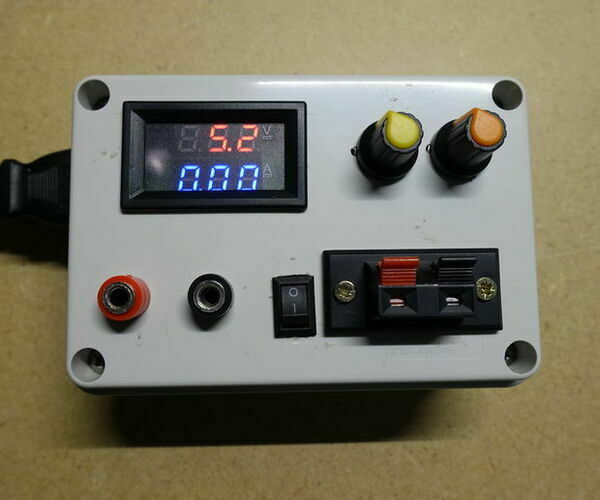
CC/CV Power Supply
"Power supply is one of the most important tool on your workbench, but they are too expensive (like >50 for the 30v 5 amps version).Today I want to make a good and cheap power supply, it will not be precise like what you buy, but it will cost less than 20. This power supply can be used in different cases: is a CC/CV that mean constant current/costant voltage so is perfect to charge lithium battery and almost any type of battery, but make attention when you do that, it can be very dangerous in case you wrong to set voltage or if the battery are damaged, so please, don't do this if you are not an expert.generic power supply up to 18 v and 4 amps (in my case, depending on wich power supply you will choose) you can power your new circuit with the current limitation, so if something went wrong you don't broke everything" [...]

Tweerstationneke A.k.a. Dutch WeatherStation
"My dad is always interested in the latest news and the latest weather information. So that brought me to the perfect birthday gift when he became 76: A small alway-on weather station with no nonsense, it just sits quietly in a corner all day and gives a summary of the latest predictions. It is designed around two Dutch websites. Probably you can see that on the funny local title of this topic! One gives the local forecast per city every 10 minutes in json format. The other one gives the rain forecast for the next two hours in plain text format which is always handy to know." [...]

3x3x3 LED Binary Counter Cube
"I assembled for my grade 12 Computer Engineering final project. The goal was to fabricate any circuit that used a 555 timer IC chip. I liked the way LED cubes looked and perhaps the challenge of it too, so I went with arguably the most complex one. Making homemade/DIY PCBs had its pros and cons. Pros: quite a bit of learning from it, more hands-on, pretty affordable Cons: copper clad boards could burn easily, takes time and some tools As previously mentioned, the copper clad boards burn pretty easily, so that combined with the thin layer of copper which would oxidize kind of easily caused a lot of the copper to come off. Hence, the less than hobbyist and far from professional soldering seen in the later photos." [...]

Making the Drill Press. Is It Worth It?!
"In this instructable / video I will be making my designed homemade drill press with the model 775 motor. It's speed will be controlled with the 10A PWM speed controller. Also I will provide key tests for you to decide if it is worth time and effort to make a tool like this. FINAL DIMENSIONS - http://bit.ly/DIY_Drill_Press_Dimensions Provided Amazon links are affiliates. (You can buy through them to support my work) Main Tools You'll Need: Drill Jigsaw Clamps Speed square Soldering kit: Main Materials You'll Need: Plywood 12mm (1/2) thickness Plywood 18mm (3/4) thickness for the base Drawer sliders 30cm (12inch) Tension springs Model 775 DC Motor https://amzn.to/2Inbha3 or model 895 DC Motor (needs 12-24V 10A PSU) Chuck 0.6-6mm Bracket for 775 motor or for 895 motor 10A speed controller for 775 motor 20A speed controller for 895 motor Closed 24V 5A power supply for 775 motor Open 24V 10A power supply for 895 motor Other Things You'll Need: Screws, bolts, washers, self-locking nuts, wood glue, wires. " [...]

Enhanced ESP8266 Based WiFi Fan Speed Regulator
"This instructable will guide how to make an Ceiling Fan Speed Regulator using Triac Phase angle control method. Triac is conventionally controlled by Atmega8 standalone arduino configured chip. Wemos D1 mini adds WiFi functionality for this regulator. Featuring - 1. Both local and wifi controlled (Push button & Smartphone wifi). 2." [...]

Esp32 Air Monitor
"In this tutorial, you will build an air monitor that monitors air temperature, humidity and pressure, all using Blynk, an esp32, a DHT22 and a BMP180. Supplies: esp32 Microcontroller DHT22 BMP180" [...]

60Hz Arduino Clock
"This Arduino based digital clock is synchronized by the 60Hz power line. It has a simple and inexpensive common anode 4 digit 7 segment display which shows hours and minutes. It uses a cross over detector to detect when the incoming 60Hz sine wave crosses the zero voltage point and derives a 60 Hz square wave. Over short time periods the frequency of the incoming sine wave from the power line may vary very slightly due to load, but over long periods of time it averages to 60Hz very precisely. We can take advantage of this to derive a timing source to synchronize our clock. There are two versions of the circuit depending on whether you want to use a transformer with a center tap or one without, in either case the circuit operation is almost identical." [...]
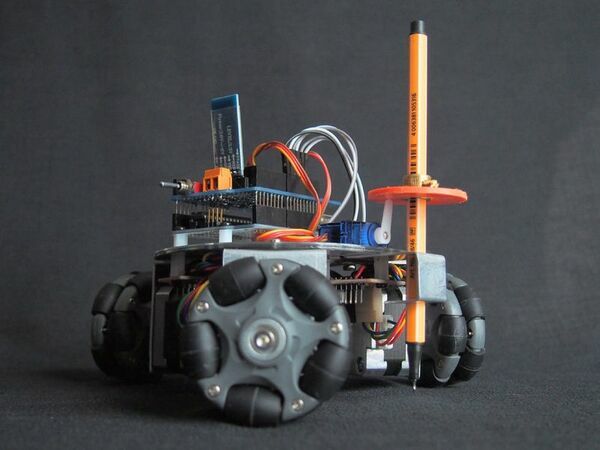
Omni Wheel CNC Plotter V2
"An “Omni-wheel” only has traction in the direction of rotation. This instructable explains how to make an XY plotter from three Omni-wheels, three NEMA 17 stepping motors, an Arduino Uno R3 microcontroller, an SG90 servo, and an HC-06 bluetooth module. The plotter is a three-wheel version of the four-wheel plotter described in my instructable https://www.instructables.com/id/Omni-Wheel-CNC-P... The metal-work in this new design is much simpler and has been kept to a minimum ... all you need is a screw-driver, two drills, a rat-tail file, and a sharp knife. The plotter has an on-board interpreter that recognises the g-code output from “Inkscape”. All that is required is an XON XOFF terminal that can send text-files one line at a time." [...]
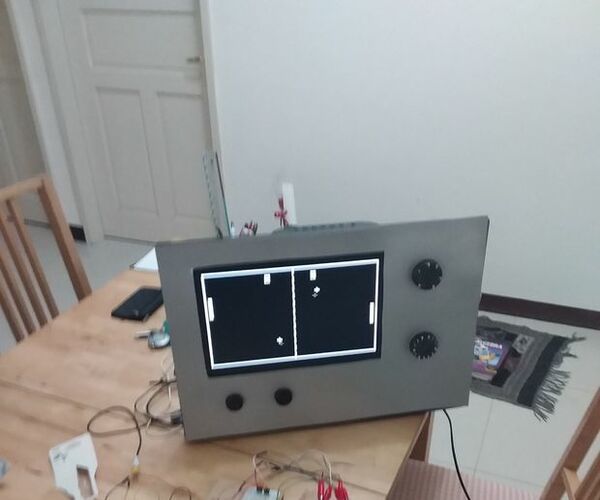
Arduino Old-Style Pong (TVout)
"Aesthetics: The aesthetics of this project were designed entirely by me, but I was inspired by the idea of 1950s televisions. The materials used for this project were designed to be easily accessible & producible by the public, and as such are poor quality in look. Code: The code in the final section is a cleaned up version of the Arduino Pong code, that has corrected multiple errors on the other website (such as the error of having the pins wrong). The code also had many delays that crashed the Arduino upon setup. I had help with the C-code of the Arduino setup, and I do not claim this work to be solely via my effort. Supplies: Doing this project will require you to have: A television that can receive RCA wires One RCA cable An Arduino Board (Leonardo/Uno) & a breadboard 1 470R resistor 1 1kR resistor 6 alligator clips (Optional, but prevents a lot of messy soldering) 2 10k Ohm potentiometers Jumper Cables (around 10) Soldering gear (Wire, Iron, Flux) RCA Socket (Used for my method) 75R Resistor (Used for my method) The code in the software section (Optional) Cardboard (Optional) Spray Paint (colour of tv) (Optional) Bottle Caps (to become buttons) (Optional) 1 Marker Pen (preferred colour of buttons) (Optional) Glue (to stick the buttons)" [...]
The Iconic Whack-a-Mole Has GONE WILD
"Whack a mole, a worldwide popular arcade game, is truly a classic. However, ever since the video game consoles, PC games, and VR technology emerge onto the market, people seem to turn their attention towards indoor games - without having to visit an arcade club. Arcade machines were soon ruled out of the popular market; people could barely find one in the streets of Taipei. In order to revive my childhood memories, I began a project on combining Arduino technology with the casual, old-fashioned whack a mole game techniques. Three main goals for this product: 1. Portable." [...]

10 Million YouTube Subscribers Award LED PCB
"Summary This PCB (Printed Circuit Board) resembles the YouTube Play Button award that is given out to creators for reaching certain milestones such as 100,000, 1 million, and 10 million subscribers. When the switch is turned on, the user can scroll through 5 different modes by pressing the button on the top left corner. The first mode leaves all the LED's OFF, the second is silver (100,000 subs), the third is gold (1 million subs), the fourth is a sparkling diamond effect (10 million subs), and the fifth, just to match the board color, is all red. The board is about 150mm x 100mm, it has holes in the corners so it could be mounted somewhere, however, I have not mounted it to anything. The board is currently powered by a 3.7-volt drone battery, I might change this so that I can just leave it plugged in and mount it somewhere and not have to worry about changing the battery as it only lasts about 30 minutes with the LEDs at full brightness. This board was built for a Special Topics Class at Berry College taught by Zane Cochran who had the idea of using images to design and inspire PCB builds." [...]
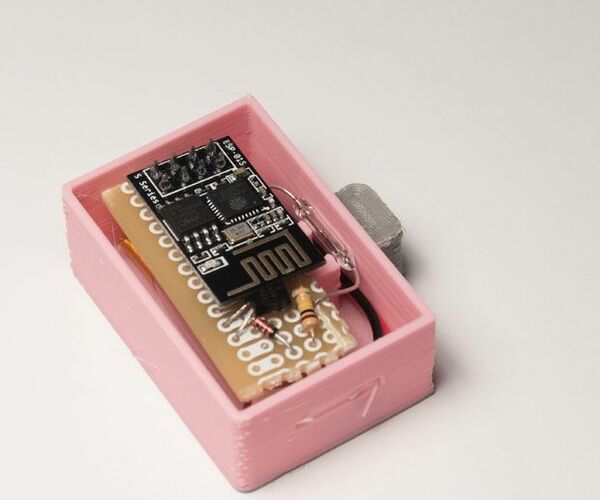
LEIDS - Low Energy IOT Door Sensor
"What is LEIDS? LEIDS is an IOT sensor that is based around the ESP8266. This sensor makes use of this board, a soft latching circuit, a reed switch, and some magnets to create a door sensor that will send you an alert when your door opens and closes. This sensor can be hooked up to your MQTT server, IFTTT, or many other frameworks that support the ESP8266. This instructable will use IFTTT to easily create a sensor that will send an alert to your mobile device no matter where you are. The sensor can also be setup to allow for multiple alerts from separate doors, mailboxes, ovens and anything else that has an open/close or on/off physical position." [...]

1750Hz tone generator
"The 1750Hz tone bursts are often used to trigger repeaters. There are several methods to build 1750Hz tone generators which including TC5082 divider, using MCUs, etc. In this post, I present another 1750Hz tone generator which I built using 74HC4060 high-speed 14-stage binary ripple counter and 7.168MHz crystal. In this design, 74HC4060 is used to drive the crystal and divide its output by 4096. By using 7.168MHz crystal, this circuit produces 1750.0Hz square wave output with a 50% duty cycle. This circuit is extremely simple to build, and I construct my prototype using a breadboard." [...]
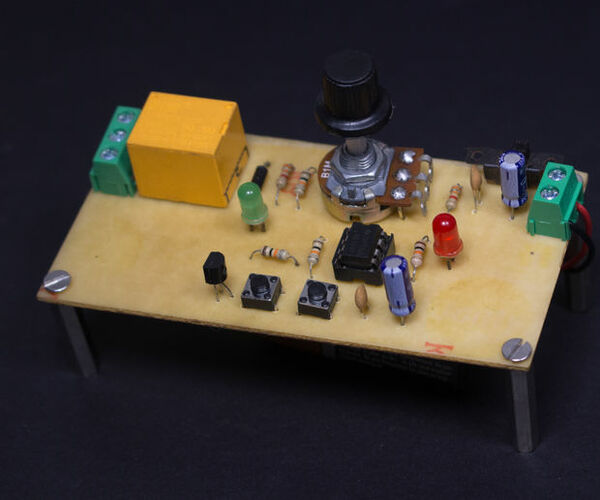
Adjustable Timer Switch
"Learn how to make a precisely adjustable timer with a variable delay from 1 - 100 seconds that uses the 555 IC. The 555 timer is configured as a Monostable Multivibrator. The output load is driven by the relay switch which is in turn controlled by the timer circuit. Since the project only involves assembling a simple circuit by following the schematic, it will only take an hour to make. " [...]

Weather-station With Arduino, BME280 & Display for Seeing the Trend Within the Last 1-2 Days
"Hello! Here on instructables weather stations have already been introduced. They show the current air pressure, temperature and humidity. What they lacked so far was a presentation of the course within the last 1-2 days. This process would have the advantage that you can not only graphically read the current values but also at a glance, see how they have changed in the last 1-2 days. As a result, one recognizes, for example, a possible change in weather, as the air pressure changes greatly." [...]
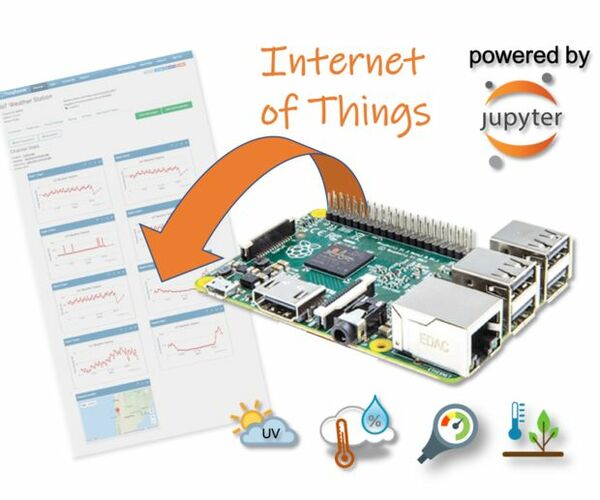
RPi - IoT Weather Station
"On this tutorial we will get data from several different sensors, sending them to an IoT service, ThingSpeak.com and to a mobile App (Thingsview), where we can log and play with data. We will explore several different communication ways of connecting sensors to a Raspberry Pi, as: DHT22 - Temperature & Humidity Sensor - Digital Comm DS18B20 - Temperature Sensor - 1-Wire BMP180 - Temperature & Pressure Sensor - I2C UV - Ultra Violet Sensor - Analog Sensor via A/D and SPI bus In short, all data will be captured, saved locally on a CSV file and send to an IoT service (ThingSpeak.com), via MQTT protocol, as you can see on below block diagram: To complete a real Weather Station, on the final step, you will also learn how to measure wind speed and direction, following Mauricio Pinto's tutorial. Supplies: Raspberry Pi V3 - US$ 32.00 DHT22 Temperature and Relative Humidity Sensor - USD 9.95 Resistor 4K7 ohm DS18B20 Waterproof Temperature Sensor - USD 5.95 Resistor 4K7 ohm BMP180 Barometric Pressure, Temperature and Altitude Sensor - USD 6.99 UV Sensor - USD4.00 Adafruit MCP3008 8-Channel 10-Bit ADC With SPI Interface - USD 5.98" [...]

3D Printer Laser Modification
"Most of my DIY projects make use of a 3D printer. The big advantage is that you can design and make your own 3D objects. In a previous instructable I've assembled and improved an Anet A8 3D printer. And after a few improvements, this printer gives a nice result. In addition to a 3D printer, it can be useful to use a CNC machine or a laser cutter. I've already attached a dremel to the Anet A8 3D printer." [...]
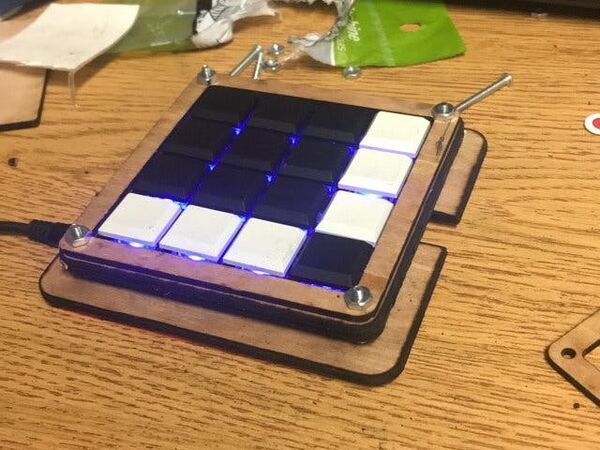
Multipurpose Keypad
"A 4x4 keypad that uses mechanical switches with individually backlit keys powered by an Arduino Pro Micro. This is a 4x4 keypad that I designed and built in my first year of college. My intent for this project was to use it as an external number pad/macro pad for my laptop. It also doubles, as a good controller to play games or control a robot with. While working on this project I learned a lot about PCB design, from creating the schematic to laying out the components and connecting everything together. I also learned how to read a key matrix and create LED patterns in code." [...]

DIY Budget 3D Scanner V3
"Hey guys, it has been a while I didn't publish any instructables. This time, I brought to you guys one of the project I made back in Feb 2019. The version 3 Budget 3D Scanner! So, lets get started! " [...]

How to Make Colour Sorting Machine
"Hello friends here I have made a candy colour sorting machine Using arduino nano, Nema 17 stepper motor and a TCS3200 Colour sensor In this project Color sensor detect the color of candy and generate output in this output sensor data transfer to arduino arduino will process those data according to code uploaded in it and command servo to move and sort color candy on basis of there color. " [...]
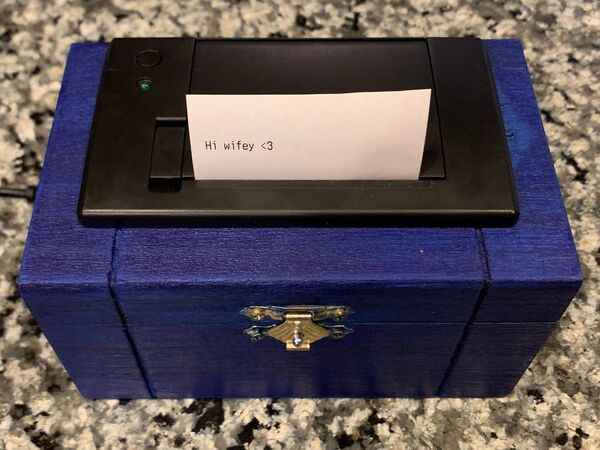
Love Notes
"A small portable box that prints messages sent by a loved one. My wife goes out of town for work regularly, and I wanted an extra way to send her something special while she was travelling. I came up with the idea to make Love Notes, a small box that she could plug in at her hotel which I could use to send her little messages during the day. Setup - Hardware Cut a hole in the box and place the thermal printer inside. Follow the schematic at the bottom of this project to connect the thermal printer to the Electron and to power. Plug the Soracom SIM into the Electron." [...]

Blimp DIY
"Build your own DIY remote-controlled blimp for flying for sport or for commercial use. Story This is a showcase of a DIY Blimp project. I created an indoor blimp demo that leverages TI LaunchPads and BoosterPacks. I wanted to combine my passions of remote-controlled (planes, cars, boats, helicopters and quads) with my engineering background and work. I started the build with a blimp kit that included the envelope, fins, gondola, dc motors and a few 3D printed parts for tilting the motors. I programmed the 5529 LaunchPad to take inputs from the user joystick and push buttons." [...]
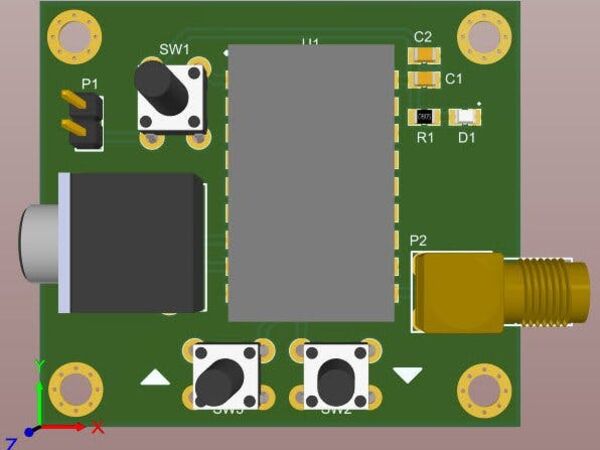
How to Build a Digital Coil-Less FM Transmitter
"Learn to how to build an easy, stable and digitally controllable FM transmitter. Story An FM transmitter is one of the most popular devices between electronic hobbyist, professionals and even non-technical people. In this article, we are going to learn to how to build an easy, stable and digitally controllable FM transmitter. For this design, I have selected the VMR6512 module which truly is like a full RF block on a chip!. It eliminates all essential circuitry for a basic FM transmitter such as inductors and trimmers. According to the VMR6512 datasheet: “VMR6512 is a highly integrated FM audio signal transmitter module." [...]

Torus Drawing Machine
"This is a machine which draws a torus. It is based on a ruler, two modified servo motors and some 3D printed parts. One of the motors has a 3D printed wheel attached with offset mounting holes. The marker slider is attached to this wheel with a metal linkage. As the 3D printed wheel turns, the marker slider moves back and forth linearly across the ruler. At the same time the other servo drives the entire machine in circles around a center pivot using a skate wheel." [...]
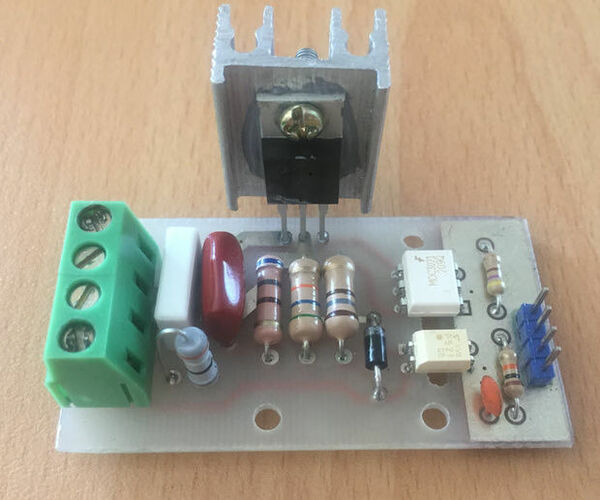
How to Build an Isolated Digital AC Dimmer Using Arduino
"Disclaimer: This circuit is connected directly to the mains voltage. You must care about all safety precautions before using the device. AC loads are everywhere around us because at least home appliances are supplied with the mains power. Therefore, we always face the situations that we want to have full control (dimming) over an AC load such as a lamp, a motor, vacuum cleaner etc. We should know that controlling an AC load is not identical with a DC load. So we should use different electronic circuits for this purpose." [...]

Dual 7-segment Displays Controlled by Potentiometer in CircuitPython - Demonstration of Persistence of Vision
"This project uses a potentiometer to control the display on a couple of 7-segment LED displays (F5161AH). As the potentiometer knob is turned the displayed number changes in the range 0 to 99. Only one LED is lit at any moment, very briefly, but the eye or a camera does not notice the flicker. This is persistence of vision. Pressing the button slows down the action and you can see the individual LEDs turning on and off. I've noticed that there are very few Instructables using CircuitPython so this project uses an Adafruit Itsybitsy M4 development board which runs CircuitPython beautifully." [...]
That's all Folks!



